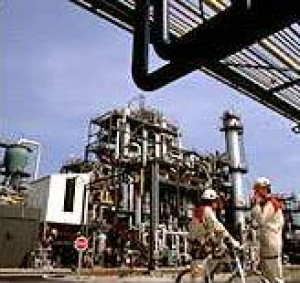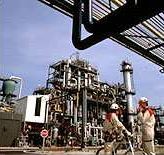In a synthetic rubber unit, a pressure spike on the demineralised water network at 3:30 pm began disturbing height verification performed at the cement/water + catalyst interface in a settling basin, causing 10 to 15 tonnes of cement to be transferred to the cooling tower. This control was being carried out at 2 interface levels, the first one flushing (i.e. cleaning and anti-clogging by means of injecting demineralised water) while the other with a membrane was undergoing testing. By 7:10 that evening, the flushing level had drifted towards 97%, while the membrane level had dropped to 3%. At 7:30 pm, a technician making his rounds detected a hexane smell (without tripping any explosion meter) and the presence of cement. On one unit, it was observed that the flushing showed a zero flow rate, thus leading to an erroneous interface measurement plus cement flow at the bottom of the settling tank towards the cooling tower and the pit where liquid effluent was being collected. Once identified, this incident was held in check until around 8:30 pm, i.e. 1 hour after the completion of cement injection and a return to normal flushing level operations, when the cooling tower and pit ignited at the surface. The internal emergency plan was activated for 50 min; the fire was brought under control by 8:50 and fully extinguished at 9:20 pm. The unit sustained damage.
This incident revealed a lack of reliability in the flushing level technology, which proved even more sensitive when these levels were located at the end of the demineralised water network. The ignition was probably caused by static electricity coupled with a phenomenon of “splash filling” or accumulation of electrical charges generated by contact with rainwater running off the water/hexane mix at the cooling tower surface. Two other hypotheses were also forwarded:
- a hotspot corresponding to the accumulation of condensed vapours at the level of a flow meter bleeder on the soda line tracking circuit associated with the pit; these temperatures however were considerably lower than the hexane self-ignition threshold;
- a temperature rise due to mechanical friction (tower fan motors or pit booster pumps leading to the heavy metal basins).
The installations were restarted on 2nd December. Several actions were conducted at this time: verification and eventual repairs of both the atmospheric refrigerant cell on the northern cooling tower (left unaffected by the incident) and the pit cell, which had been taken offline on the cooling tower damaged by fire; and assignment of the northern cell (used solely during summer to cool the effluent of another basin) to the current stemming from the demineralisation process via a pipe installed between the northern and southern cells. Given the improved membrane level reliability, the implementation of this level was accelerated and completed on 12th December, with the flushing level retained for the time being but eventually eliminated during installation of a radioactive source densitometer (i.e. cobalt probe) at the end of the 1st quarter 1997. A training programme dedicated to this technology and its implementation procedures during settling tank cleaning operations was offered to staff technicians. An emergency drill was scheduled during the upcoming year based on a scenario involving radioactive sources. Subsequent to this incident, the valve located on the automatic valve bypass at the settling tank outlet was locked shut, while the gas detection system was upgraded near the tower. Towards this goal, the operator studied the possibility of improving system reliability through the use of a single threshold with a sound alarm; moreover, the operator installed an explosion meter on both adjoining towers at the cell outlet heading towards the pit and sought to integrate a technology compatible with water vapour so as to equip the head of the tower with a 3rd explosion meter. The vapour tracking circuit bleeder on the tower’s soda supply line, which was capable of constituting a hotspot, was routed belowground. To avoid exposing personnel during an accident, the pump and fan controls were moved outside of zones potentially containing hexane vapours. Lastly, an emergency procedure was drafted and inserted into the mandatory training modules (e.g. shutdown of the polymerisation line, channelling of settling tanks into the sewer, guidelines to avoid stopping fans, ban on climbing onto the tower’s upper platform, precautions to be taken prior to initiating pumping, sprinkling practices to help prevent against the ignition risk).
Download the detailed report in .pdf format (82 Kb)





